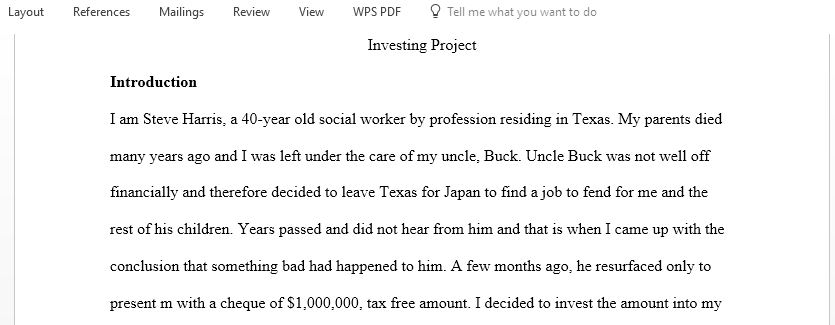Investing Project
Investing Project – Due in Class 8 – Due in Class 8. You just inherited $1,000,000 (tax free) from your long-lost Uncle Buck, who found a lost gold mine in the Aquarius Mountains of Arizona. [Some people have all the luck!] You have decided to invest your inheritance for retirement. So, your assignment is to create a retirement investment portfolio with this $1,000,000. Your portfolio must consist of at least 3 equities (stocks), 3 mutual funds including at least one stock fund and one bond fund. You can also explore ETFs, these are optional. You can save any leftover funds, but state where would you save them: short-term Treasury debt (bills and notes)? a CD? a Savings Account? a Money Market Account or Fund? These leftover funds cannot be more than 5% ($50,000) of your total amount inherited. You must explain the tax consequences of each investment selected and how any taxes will affect the projected gain or income for you. This project consists of a 7 page paper and 1 summary sheet.
1. Briefly discuss your personal situation: family status, years until retirement, life expectancy and years in retirement. Provide a vision of what retirement looks like for you (and significant other, if appropriate). How many years will you be in retirement? You can go to http://gosset.wharton.upenn.edu/mortality/perl/CalcForm.html and
http://www.ssa.gov/OACT/population/longevity.html to determine your life expectancy (it would be better to go to both).
2. Determine and discuss your risk tolerance. Are you a conservative, moderate or aggressive investor?
How did you arrive at your risk tolerance? A good site from which to measure your risk tolerance is:
http://njaes.rutgers.edu/money/riskquiz/.
As a very general guideline here’s a beta chart that might be helpful when selecting your securities: Risk Tolerance Beta Range Low 0-.5, Medium .5-1, Aggressive 1+. This is not to say that you can’t have some higher beta’s in your portfolio if you are low to moderate – just keep it at 5-10% of your portfolio.
3. Select and research the investments required in your portfolio. Discuss why these are appropriate investments for your risk tolerance and retirement plan. Discuss the investment objective of the mutual funds you have chosen and the type of stocks you selected with regard to risk and market volatility. Do not cut and paste investment information in this paper. You must explain the tax consequences of each investment selected and how any taxes will affect the projected gain or income for you. You should analyze and synthesize the investment information into a personalized investment plan. Be thorough with the performance data. Why did you select the investments? How do they meet your needs? Did you buy or refrain from buying any securities because of your personal beliefs (socially conscious investing)? How have they performed – both recently and over the years? What are their current yields? What are the yields over a longer term? What expenses are associated with the instruments – i.e. expense ratios for the mutual funds? How do they compare to other similar investments? How much did you invest in each investment? How many shares where you able to buy? Do not discuss the generalities of investing: this paper is about YOU, your investment goals, and investment strategies. Be very detailed in your paper.
4. Determine the ending portfolio value at retirement. Discuss your assumptions on arriving at this number. Use time value of money calculations to estimate your ending balance at retirement. Consider a constant return of 4-6% for the long term.
5. Create a one-page only Investment Summary Table (schedule) of your investments showing the type of investment, ticker symbol (the abbreviated letter designation for the security), name of the security, investment objective for mutual funds, risk factor, rate of return, cost, and projected balance at retirement. Sum up all the future balances to show your projected total investment balance at retirement.
6. As an exercise to better understand bonds and bond mutual funds, pick one bond (not a bond mutual fund). This bond will not be part of your $1,000,000 investment portfolio. Indicate the type of bond, name of the bond, maturity date, coupon, risk factor, and cost. What is the bond’s current yield? Projected rate of return?
7. Paper Requirements: Submit a 7-page (minimum) narrative paper discussing the portfolio you have created. Charts and graphs are extra pages and do not count in the 7 pages of narrative. Charts/graphs should be referenced in the paper. Internet printouts and other copies do not count at all toward paper length, but may be submitted as supporting documents (and are encouraged).
8. Works Cited are required for all your research sources (foot-notes or end-notes). Remember, you have $1,000,000 to invest. NO MORE AND NO LESS! This is “real life”. You cannot buy fractional/partial shares of stock. You may buy fractional/partial shares of mutual funds. Give me the real numbers.
Answer preview for Investing Project
Access the full answer containing 1950 words by clicking the below purchase button

